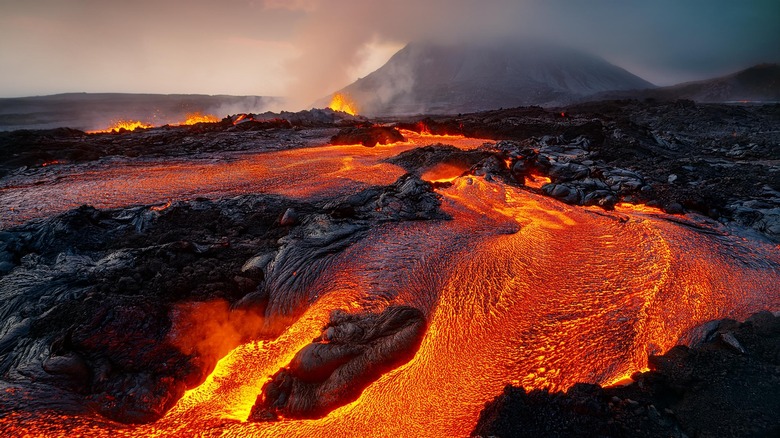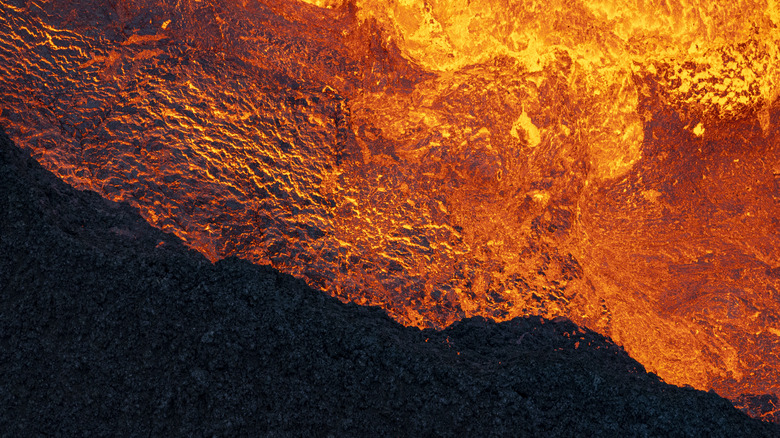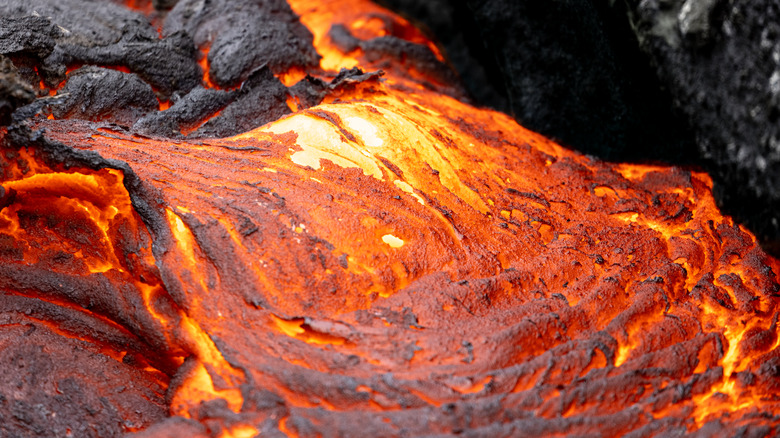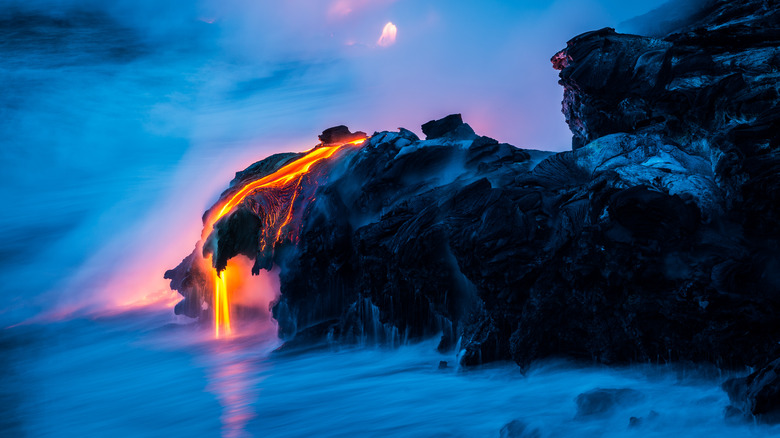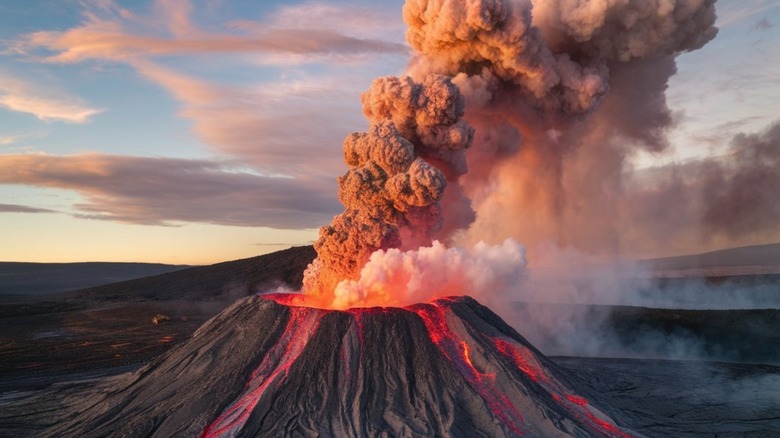What If You Fell Into Lava?
In the 1997 disaster thriller "Volcano," Los Angeles Public Transit Chair Stan Olber finds himself carrying an injured passenger off a metro train that's quickly being engulfed by a river of lava. Reaching the end of the car, he sees the volcanic material has already advanced beyond the point of safe return. Olber makes the heroic decision to jump anyway — landing directly in the lava and tossing the passenger beyond its reach to a nearby team of rescuers. Within seconds, Olber, whose death is horrifically and absurdly portrayed by John Caroll Lynch, has melted up to his chest, screaming in Shakespearean agony while what's left of him bursts into flames.
Humanity's fascination with lava is nothing new. Cultures around the world have built up millennia-spanning mythologies around the volcanoes (like Mount Kilauea, the Hawaiian volcano that's barely stopped erupting since 1983) that produce it. Hollywood's obsession with lava is likewise well documented, having reached a fever pitch in 1997, a year that saw two blockbuster volcano disaster movies, "Dante's Peak" and "Volcano," enter the public discourse.
But what would actually happen if you fell into lava? As morbid as the thought may be, it's a perfectly reasonable thing to wonder, like how long you could survive in space without a spacesuit or how the body would respond to the incredible pressure at the bottom of the ocean. Would you painfully disintegrate within mere seconds, like Stan Olber? Or would you be able to make it out with your life (and hopefully all your limbs) intact? The science behind the question involves some fascinating facts about geology and biology, so let's take a look.
What Hollywood gets wrong about lava
First things first: According to geologists, most cinematic portrayals of people falling into lava — including Gollum's grotesque fate at the end of "The Lord of the Rings: The Return of the King" when he falls into the furnace of Mount Doom — get it wrong.
"The more I thought about it, the more I thought that pretty much every scene I've ever noticed where somebody falls into lava and dies has got to be wrong," volcanologist Erik Klemetti wrote of Hollywood's lava-death portrayals in WIRED in 2011. Klemetti notes that the death scene featuring the transit director from 1997's "Volcano" is a particular offender here: "The guy jumps from the subway, but not far enough to miss landing in maybe 6 inches of basaltic lava, and he proceeds to more or less melt away into the lava like the Wicked Witch of the West. Not likely."
The reason for this boils down to (pun intended) density. While it might be tempting to think of lava as if it were the same as water, it doesn't behave or have the same properties as that substance. Water's density weighs in at around 1,000 kilograms per cubic meter. Lava, on the other hand, has a density of roughly 3,100 kilograms per cubic meter, making it three times denser. Lava is also around 100,000 times more viscous than water (viscosity being the measure of a liquid's resistance to change in movement or shape). Put those two together, and the result is that a human body, which has a density of around 1,000 kilograms per cubic meter, is just not hefty enough to sink rapidly into lava. Nor is it true that when something hits lava, it ripples or splashes like water — usually, it barely moves at all.
What would actually happen
While the movies might get the specifics wrong, falling into lava is going to ruin your day. To start, let's look at what happens when lava moves over a proxy organic material: vegetation. According to the United States Geological Survey (USGS), lava coming from Mount Kilauea, for example, has a temperature of roughly 1,150 degrees Celsius (or 2,100 degrees Fahrenheit). That's enough to rapidly bake organic matter, accelerating biomass breakdown at the chemical level.
For humans, getting a limb caught in a lava flow will result in severe burning that can literally boil the fat in your body. If you don't get out quickly, the burns will penetrate into muscle tissue, causing permanent damage. If you fall in entirely, the water in your body will turn into steam while the volcanic material goes to work on your tissue from the outside, charring your skin to a carbonized black husk. In all likelihood, though, you'd be spared the worst of this pain. Volcanic gases contain enough carbon dioxide to make you pass out and die just from inhaling it.
That's perhaps for the better. While you're "floating" on the lava's surface, the gases inside your organs would cause you to, well, explode. "The basic idea is that the gases in a body would expand rapidly and probably cause a series of minor explosions," Adam Kent, a volcanologist at Oregon State University, told Digg. This was the fate of a bag of organic matter thrown into Ethiopia's Erta Ale Volcano during an experiment in 2002. The bag was dropped from a height of 80 meters (260 feet), and upon impact, it penetrated the lava pool below and caused a series of explosions.
Real life lava incidents: survivors and fatalities
Lava accidents are rare, but they do happen. In some cases, people have survived brief encounters with molten rock, while in others, even indirect exposure has proven lethal. One of the few known cases of a person surviving direct contact with lava took place in August 2007 at Ol Doinyo Lengai, an active volcano in Tanzania. A local Maasai porter accidentally fell into an active lava flow at temperatures of 500 degrees Celsius (932 degrees Fahrenheit) but managed to pull himself free. However, he sustained significant burns on both legs and one arm. One of the factors that may have contributed to his survival is the fact that the lava at Ol Doinyo Lengai burns hundreds of degrees cooler than typical basaltic lava flows.
Another example involves United States Geological Survey (USGS) geologist George Ulrich, who, in 1985, was conducting fieldwork at Hawaii's Mount Kilauea. While collecting lava samples, Ulrich accidentally stepped onto recently cooled lava, breaking through the surface to a depth that passed his boots. Unable to free himself, he dropped to his knees in an attempt to escape. Ulrich's field partner managed to pull him out a few seconds later. Though he survived, Ulrich sustained first-degree burns on his arms, hands, and face, and second and third-degree burns from his feet to his upper legs.
Even just being around volcanic activity can be deadly. In April 2006, three ski patrol members at Mammoth Mountain in California were fencing off a known volcanic fumarole — a vent emitting volcanic gases — when the snow around it collapsed. Two members fell into the fumarole and immediately lost consciousness by inhaling toxic gases. A third member of their party attempted a rescue but also succumbed to the gases. All three tragically died from asphyxiation.
How to survive a volcanic encounter
Volcanoes are no joke. Their raw power and lethal nature are just a couple of the reasons why they are found at the heart of the most hostile environments that exist on Earth today and how they have caused some of the most deadly and destructive events in U.S. history. They are truly awesome natural spectacles that captivate and demand respect in equal measure, which is why adhering to safety guidelines while visiting or just being near one are more than mere formalities, they are tools to ensure your survival.
During a volcanic eruption, no matter how big or small, the U.S. Geological Survey (USGS) advises individuals to maintain a safe distance from lava flows, vents, and craters, as the heat and gases from these can be extremely hazardous. The International Volcanic Health Hazard Network (IVHHN) recommends carrying masks to protect against inhaling fine ash and wearing goggles to prevent eye irritation. If volcanic activity escalates, following evacuation orders promptly can be the difference between life and death. At the end of the day, your location will determine what action you should take: shelter or evacuate.
Preparation is key when visiting or living in volcanic regions. Geological experts advise carrying an emergency kit containing masks, protective eyewear, a first aid kit, and plenty of water. Monitoring official updates from geological agencies is another way to ensure you stay informed about potential eruptions. By respecting volcanic environments and taking the proper precautions, you can safely experience these natural wonders without risking your well-being. Remember, volcanoes aren't how they are portrayed in the movies — they are far more inspiring, humbling forces of nature that reward curiosity and reverence.
